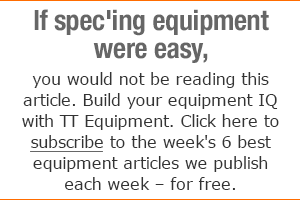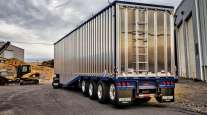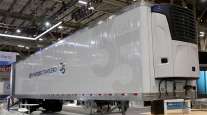Senior Reporter
Trailer Orders Boom Amid Nonstop Demand
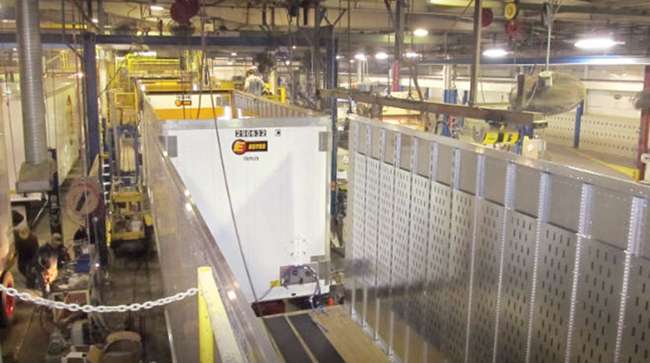
Records keep falling. U.S. trailer orders reached 38,200 in August, the most ever for the month, ACT Research Co. reported.
At the same time, the cost of materials is rising, supply chains remain stretched and parts shipments arrive incomplete or late, trailer makers said.
August’s total exceeded by 11,000 the previous record for the month, set in 1994. It followed demand for trailers in July that shattered that month’s previous high, too. A similar record-setting pace occurred with Class 8 truck orders in August and July as well.
August’s trailer volume, based on preliminary data, was up 140% from a year earlier, when orders were 15,899, according to ACT.
“It’s the old three-legged stool — fleets need capacity, hear the freight volume is going to be there and they have the ability to buy,” so they ordered, said Frank Maly, ACT’s director of commercial vehicle transportation analysis.
Most of the strength, he said, came from the dry van and refrigerated segments, with reefer trailer orders up 240% year-over-year — “in round figures” there were 7,900 reefer orders in 2018 compared with 2,300 a year earlier.
Maly estimated backlogs are out six to seven months on average, and significantly longer in some cases. So far, there hasn’t been much cancellation activity.
“We, like other trailer manufacturers, have been experiencing unusually high new trailer demand in all segments that we serve. Most of the demand is for replacement and not expansion, but some is expansion,” Craig Bennett, senior vice president of sales for Utility Trailer Manufacturing Co., told Transport Topics.
“Costs are continuing to rise into the 2019 timeframe, and supply lines are particularly tight, and being strained in many cases to capacity and beyond already this year,” he said.
Utility receives many material shipments that are short and late, he said.
“Our customers are very busy and are passing on cost increases in the form of higher freight rates,” Bennett added.
Research firm FTR pegged the orders at 35,300 units.
“It’s not just trucks and trailers. The industrial economy is just booming,” and the same suppliers often serve many sectors, said Don Ake, FTR’s vice president of commercial vehicles.

Ake
“What is going to be interesting is what happens when we get to the end of the year. Do trailer makers open up the second half [of 2019, as they have now done with the first half]?” Ake said. “If not, there could be a very poor November, comparatively, because everyone’s got their orders in.”
Trailer makers’ own stock orders are a portion of what’s in their pipeline to provide equipment for customers who don’t have their own specification requirements.
At Stoughton Trailers, once those orders are completed, “our own reps sell those directly,” said David Giesen, vice president of sales.
“They are selling like hotcakes The small to midsize fleet just wants a standard air-ride trailer. We are selling [stock trailers] to the person who may want one or 50, not hundreds, at a time,” he said.
Large fleets can exert pressure to get every available slot, Giesen said.
“So you kind of have to protect this space; plug the stock orders in so you have them to sell in every given month,” he said.
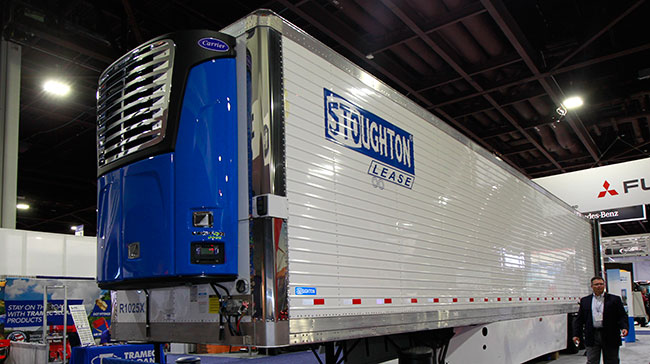
A Stoughton reefer at an industry show. (John Sommers II for Transport Topics)
Strick Group Chief Sales Officer Charles Willmott said he could not recall lead times ever being as long as they are today, even as material and component costs remain largely undetermined after Jan 1.
At Strick, the backlog reaches to July 1, he said.
“Booking all, or most, of 2019 at prices quoted today is fraught with financial risk for the trailer makers,” Wilmott said.
With demand at the current very high level, it is nearly impossible to keep all Strick’s valued customers happy, he added.
“Particularly as a smaller, specialty van manufacturer, 2019 production slots have become very hard to come by, and we spend a lot of time apologizing. It is a challenging time,” Willmott said.
At Great Dane Trailers, demand is at all-time or near all-time highs for its equipment, said David Gilliland, vice president of national accounts.
“We are a unique market place where all segments — dry, reefer, flatbed and truck body — are making buying decisions,” he said.
Simply put, fleets are ordering early so that they have production slots later, he said.
“This is in spite of the significant commodity and component increases that our industry is faced with,” Gilliland said.


